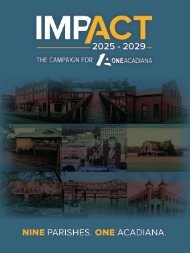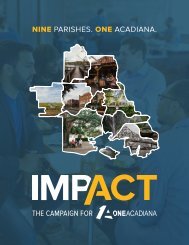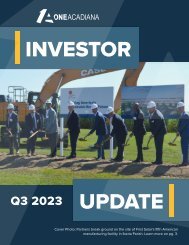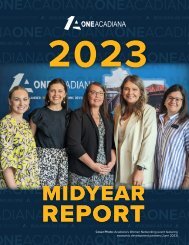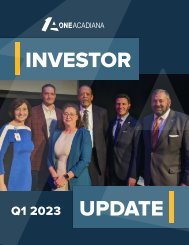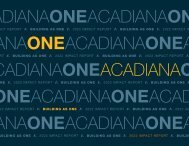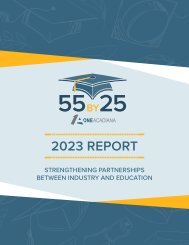Regional Infrastructure Visioning Report
- No tags were found...
You also want an ePaper? Increase the reach of your titles
YUMPU automatically turns print PDFs into web optimized ePapers that Google loves.
REGIONAL INFRASTRUCTURE<br />
VISIONING REPORT<br />
OCTOBER 2018
CONTENTS<br />
1<br />
2<br />
3<br />
4<br />
5<br />
Introduction<br />
Executive Summary<br />
<strong>Infrastructure</strong> Policy Principles<br />
<strong>Infrastructure</strong> Funding<br />
Project Selection<br />
Project Map<br />
7<br />
18<br />
Projects<br />
Roads & Bridges<br />
I-49 South<br />
University Avenue Corridor<br />
South City Parkway Extension<br />
Walmart Dist. Center Access<br />
Bayou Plaquemine Brulé Bridge<br />
I-49 & U.S. 190 Interchange Improvements<br />
U.S. 167 Improvements in Evangeline Parish<br />
I-10 Improvements in Jeff Davis Parish<br />
I-49 Midway Corridor Initiative<br />
LA 94 Improvements<br />
LA 13 Overlay<br />
New LA 182 Bridge<br />
New I-10 Bridge Over Calcasieu River<br />
Ports & Airports<br />
Acadiana <strong>Regional</strong> Airport Access Road<br />
Acadiana Gulf of Mexico Access Channel (AGMAC)<br />
Dredging at Port of Morgan City<br />
New Terminal at Lafayette <strong>Regional</strong> Airport<br />
Noise Pilot Program at Acadiana <strong>Regional</strong> Airport<br />
22<br />
Flood Mitigation<br />
<strong>Regional</strong> H&H Model<br />
<strong>Regional</strong> Stormwater Retention/Detention<br />
24<br />
Additional Needs<br />
Rural Broadband
Executive Summary<br />
Plotting a Course for Acadiana’s Future<br />
Louisiana’s infrastructure is at a crossroads, illustrated through bridge closures on critical routes; crippling<br />
delays on congested roadways; missed economic development opportunities through underserved road,<br />
port, airport, and railway facilities; and one of the highest traffic fatality rates in the country. We can either let<br />
our transportation system continue to deteriorate, or we can invest in a 21 st century infrastructure system.<br />
Business leaders understand that strong infrastructure networks drive growth and investment, and One<br />
Acadiana consistently recognizes the need to invest in modernizing Acadiana’s infrastructure as one of our<br />
top priorities. While our nine-parish region is a crucial hub for Louisiana, opportunities exist to improve and<br />
enhance our infrastructure assets to better compete to attract business, talent, and investment opportunities.<br />
This report serves as the regional business community’s roadmap for progress toward creating the modern<br />
infrastructure network Acadiana needs and deserves.<br />
KEY<br />
1A<br />
APC<br />
Corps<br />
DOTD<br />
FEMA<br />
FHWA<br />
LCG<br />
LED<br />
State<br />
UL Lafayette<br />
One Acadiana<br />
Acadiana Planning Commission<br />
U.S. Army Corps of Engineers<br />
Louisiana Department of Transportation and Development<br />
Federal Emergency Management Agency<br />
Federal Highway Administration<br />
Lafayette Consolidated Government<br />
Louisiana Economic Development<br />
State of Louisiana<br />
University of Louisiana at Lafayette<br />
1
<strong>Infrastructure</strong> Policy Principles<br />
1A employs a holistic approach to infrastructure policy, recognizing that the quality and efficiency of a<br />
community’s infrastructure affect all aspects of life and work. With that in mind, below are key principles that<br />
guide the course of 1A’s infrastructure policy and advocacy work.<br />
<strong>Infrastructure</strong> improvements are urgently<br />
needed for regional competitiveness<br />
Job creators across Acadiana rely on robust<br />
market access to move their employees, goods,<br />
and services through the region, state, and<br />
country. Ensuring that Acadiana’s infrastructure<br />
network can handle this job, while also allowing<br />
room for businesses to grow and expand, is<br />
critical to our region’s ability to retain our current<br />
employers as well as effectively compete with<br />
peers to attract new business and talent.<br />
<strong>Infrastructure</strong> investment will enhance regional<br />
mobility and commerce<br />
1A’s nine-parish region is strategically located<br />
between Houston and New Orleans, at the<br />
intersection of Interstates 10 and 49. Home to<br />
two commercial airports, five coastal ports, two<br />
inland ports, and multiple Class I and Class III<br />
railroads, our region must continue improving<br />
regional connectivity to ensure goods, services,<br />
and passengers can travel safely and swiftly<br />
throughout Acadiana.<br />
Coordinated planning will maximize resources<br />
and development<br />
Coordinated infrastructure planning efforts<br />
help to ensure that local, state, and federal<br />
resources achieve optimal impact, as well as<br />
enhance Acadiana’s economic development<br />
and tourism profile by expanding access to local<br />
communities and development sites, making<br />
them more attractive to business prospects and<br />
visitors. Additionally, planning efforts must remain<br />
focused on safety, anticipated growth, and the<br />
importance of integrating transportation and<br />
land-use planning.<br />
Quality infrastructure improves quality of life<br />
Quality of life is a key factor in attracting and<br />
retaining business and talent. Enhancing our<br />
region’s multimodal infrastructure to support<br />
safe and swift access to our schools, medical<br />
infrastructure, public parks and libraries,<br />
and the one-of-a-kind cultural activities that<br />
make Acadiana a unique place to call home<br />
is imperative to preserving and improving our<br />
region’s already strong quality of life.<br />
2
<strong>Infrastructure</strong> Funding<br />
Louisiana currently faces a transportation funding backlog of nearly $14 billion in preservation and<br />
maintenance needs on the existing highway and bridge system, with an additional $10.5 billion needed for<br />
new Priority A and Priority B megaprojects, such as completing I-49 South.<br />
Created in 1990, the state Transportation Trust Fund (TTF) is the largest source of infrastructure funding<br />
Louisiana directly controls. It is a constitutionally dedicated fund generated by the 16-cent state gas tax,<br />
vehicle license taxes, weight and enforcement permits, and interest earnings. Permitted uses of TTF revenues<br />
include the costs for and associated with construction and maintenance of state and federal roads and<br />
bridges, the Statewide Flood Control Program, ports, airports, transit, State Police for traffic control purposes,<br />
the Parish Transportation Fund, and other bond obligations for transportation infrastructure.<br />
Over the past 20 years, state gas tax revenues have declined while vehicle miles traveled on Louisiana<br />
roads have increased. Improved vehicle fuel efficiency continues to reduce consumer demand for gas, while<br />
inflation simultaneously erodes the purchasing power of the 16-cent gas tax, set in 1984 – now worth a mere 7<br />
cents in relative terms.<br />
Louisiana must increase infrastructure investment if we are to make improvements necessary to keep our<br />
region and state competitive in the global economy. To that end, 1A has established a set of high-level guiding<br />
principles for transportation funding:<br />
GUIDING PRINCIPLE 1 GUIDING PRINCIPLE 2<br />
GUIDING PRINCIPLE 3<br />
Maximize current<br />
transportation funding<br />
levels and programs<br />
Find funding for<br />
transportation from other<br />
state funding sources<br />
Support a substantial<br />
increase in transportation<br />
revenue to make a<br />
meaningful impact on<br />
infrastructure improvement<br />
View 1A’s complete Transportation Funding Guiding Principles at www.oneacadiana.org/TFGP.<br />
While the need for infrastructure investment is clear, equally clear is the need for greater transparency and<br />
accountability in how infrastructure dollars are spent. 1A continues to push for policies such as the recent<br />
SB 59, authored by Senator Page Cortez during the 2018 Regular Session. This Constitutional Amendment<br />
would help restore trust in the TTF by fully prohibiting diversions from the TTF to State Police for traffic control<br />
purposes. Louisiana voters will be asked to approve this Constitutional Amendment (No. 4) in November 2018.<br />
Other steps have recently been taken to strengthen transparency and accountability for DOTD spending and<br />
project delivery, but there is more work on the horizon.<br />
Investing in infrastructure unlocks economic development opportunities that will pay dividends in Acadiana<br />
and across the state, while providing vital improvements to safety and quality of life for all users of the system.<br />
At this critical juncture, state leaders must work together to invest in a 21 st century transportation system that<br />
will move Louisiana forward.<br />
3
Project Selection<br />
The projects listed in this report were selected after consultation with stakeholders across the region–<br />
business leaders and economic development professionals that are keenly aware of the strengths of<br />
Acadiana’s infrastructure network and its most pressing needs for the future.<br />
Following outreach to more than 85 stakeholders in all nine 1A parishes, projects were vetted based on<br />
benefit to the regional infrastructure network, in line with the following criteria:<br />
Promote economic development Improve regional connectivity Improve quality of life<br />
Promote business investment / job<br />
creation, improve access to jobs<br />
Connect municipalities / regional<br />
assets, facilitate freight movement<br />
Reduce traffic congestion, improve<br />
mobility, beautify community<br />
Enhance disaster resilience<br />
Mitigate flood risk, bolster<br />
evacuation capacity<br />
Feasible and fundable<br />
Shovel-ready, funding identified,<br />
consensus support<br />
Projects included are not ranked in order of presentation and are all considered top priorities.<br />
Spotlight Projects<br />
Several “spotlight” projects are featured throughout the report. These are projects that have been identified<br />
as regional in nature and / or are expected to require coordinated, multi-jurisdictional advocacy efforts.<br />
Spotlight project profiles will include 1A’s assessment on how these projects ranked in accordance with the<br />
above criteria.<br />
RANKING EXAMPLE:<br />
Promote<br />
economic<br />
development<br />
Improve<br />
regional<br />
connectivity<br />
Improve<br />
quality of life<br />
Enhance<br />
disaster<br />
resilience<br />
Feasible and<br />
fundable<br />
Low<br />
High<br />
4
One Acadiana Region<br />
1A’s nine-parish region includes:<br />
Acadia, Evangeline, Iberia, Jeff Davis, Lafayette,<br />
St. Landry, St. Martin, St. Mary, and Vermilion parishes.<br />
New I-10 Bridge<br />
I-10 Improvements<br />
10<br />
LA 91 Pontoon<br />
Bridge<br />
LA 13 Overlay<br />
Regionwide projects (not pinned):<br />
• Hydrologic and hydraulic (H&H) model<br />
• <strong>Regional</strong> broadband access<br />
• <strong>Regional</strong> stormwater retention / detention<br />
5
49<br />
U.S. 167<br />
Improvements<br />
Walmart Distribution<br />
Center Access<br />
I-49/U.S. 190 Interchange<br />
Improvements<br />
I-49 Midway<br />
Corridor Study<br />
10<br />
University Avenue<br />
Corridor<br />
LA 94 Improvements<br />
LFT New Terminal<br />
South City Parkway<br />
Extension<br />
ARA Pilot Program<br />
ARA<br />
Access Road<br />
AGMAC<br />
I-49 South<br />
New LA 182 Bridge<br />
Port of Morgan City<br />
Dredging<br />
6
Roads & Bridges<br />
SPOTLIGHT ON I-49 SOUTH<br />
In South Louisiana, business and community leaders and public officials are working hard to finally bring<br />
to fruition a highway project with the potential to stimulate tremendous economic growth and business<br />
investment: I-49 South. With 100 of 160 miles of the project already complete or under construction,<br />
Louisiana is closer than ever to realizing the potential of I-49 South, known as “America’s Energy Corridor.”<br />
Completing I-49 South will provide a game-changing investment for Louisiana with substantial benefits for<br />
economic development, safety, evacuation, and traffic congestion relief.<br />
I-49 South Project Status<br />
Lafayette<br />
1<br />
2<br />
3<br />
I-49 Lafayette Connector<br />
$850 million<br />
I-49 at Verot School Rd<br />
$85 - 95 million<br />
South Park Rd to<br />
Albertson Parkway<br />
frontage roads<br />
$5 - 10 million<br />
INTERSTATE<br />
Status<br />
Complete<br />
Under Construction<br />
Design Phase Complete/In Process<br />
Initial Planning/Study Phase<br />
# of Projects<br />
1 project<br />
7 projects<br />
3 projects<br />
Lafayette<br />
4<br />
St. Martin<br />
Jefferson<br />
5<br />
6<br />
Ambassador Caffery<br />
interchange<br />
$100 - 125 million<br />
Ambassador Caffery to<br />
Capt. Cade frontage<br />
$5 - 10 million<br />
Iberia<br />
New Iberia<br />
8<br />
St. Mary<br />
9<br />
Wax Lake to Berwick<br />
$270 - 300 million<br />
Assumption<br />
INTERSTATE<br />
St. Charles<br />
11<br />
10<br />
New Orleans<br />
Raceland to<br />
West Bank Expressway<br />
$1.3 - 1.5 billion<br />
7<br />
LA 92/Young St<br />
interchange<br />
$35 - 45 million<br />
Morgan City<br />
Houma/Thibodaux<br />
Lafourche<br />
4 Albertson Parkway design-build $57 million<br />
8 Railroad overpass<br />
$20 - 25 million<br />
11 U.S. 90/I-310 interchange $20 - 25 million<br />
Terrebonne<br />
Sources: Source: DOTD, Louisiana One Acadiana DOTD; One Acadiana<br />
Updated: Updated: August August 2018 2018<br />
In 2017, community partners in the Acadiana region commissioned an economic impact analysis of completing<br />
I-49 South. The study revealed significant economic gains and traffic efficiency benefits, including:<br />
• $9.7 billion increase in Louisiana’s GDP over a 21-year period following the project’s construction<br />
• 27.2 million trip hours saved by drivers by 2044<br />
• 6,000 jobs created statewide by 2044<br />
This project doesn’t just benefit Louisiana – I-49 will provide connectivity from New Orleans all the way to<br />
Winnipeg, Canada, opening the door for economic development opportunities nationally and internationally.<br />
7
Description:<br />
Fully upgrading the existing U.S. 90 to interstate standards from Lafayette to New Orleans.<br />
Purpose and Need:<br />
Even while operating at competitive disadvantage due to the lack of a fully functional interstate, “America’s Energy<br />
Corridor” continues to serve hundreds of Louisiana companies. Upgrading to interstate standards will provide a catalyst<br />
for new growth and investment by connecting communities to national and international markets. Creating a limitedaccess<br />
interstate will also reduce fatal crashes and ensure families can evacuate quickly in a hurricane.<br />
Status:<br />
More than 100 of I-49 South’s proposed 160 miles are complete or are currently under construction.<br />
Key projects remaining in Acadiana include:<br />
• Lafayette Connector ($850 million) – 5.5-mile project spanning from I-10 to just south of Lafayette <strong>Regional</strong> Airport.<br />
In early February 2018, the Executive Committee overseeing the design and planning processes for the project<br />
finalized end-to-end design alternatives to be evaluated as part of the project’s supplemental environmental impact<br />
statement (SEIS) process. A final supplemental record of decision (SROD) is expected in late 2019<br />
• Evangeline Thruway revitalization – In conjunction with the Lafayette Connector project, 1A supports efforts to<br />
revitalize the remaining portion of the Evangeline Thruway, such as through the proposed “Grand Boulevard”<br />
concept<br />
• Albertson Parkway to Ambassador Caffery Parkway ($57 million) – a design-build project to widen U.S. 90 from just<br />
north of Albertson Parkway to just north of Ambassador Caffery Parkway in Lafayette Parish. This project is on track<br />
to be completed in late 2018 / early 2019<br />
• Ambassador Caffery Interchange ($100-125 million) – constructing an interchange at U.S. 90 and Ambassador<br />
Caffery Parkway. DOTD is currently working toward full design, and the project could let for construction as early as<br />
FY 18-19, pending identification of funding<br />
• Railroad Overpass in Iberia Parish ($20-25 million) – DOTD is negotiating with landowners to come to an<br />
agreement on project scope; federal Rail Safety Program funds have been identified for the project<br />
• Wax Lake outlet to Berwick ($270-300 million) – upgrading now requires a supplemental environmental impact<br />
statement (SEIS). This process is estimated to take between three to five years<br />
Estimated Cost:<br />
The estimated cost for completing all remaining projects along the corridor is approximately $3 billion.<br />
Potential Funding Sources and Partners:<br />
Remaining projects could be funded through a combination of federal grants, State funds, local match funds, and the<br />
possibility of public-private partnerships.<br />
RANKING:<br />
Promote<br />
economic<br />
development<br />
Improve<br />
regional<br />
connectivity<br />
Improve<br />
quality of life<br />
Enhance<br />
disaster<br />
resilience<br />
Feasible and<br />
fundable<br />
8
SPOTLIGHT ON UNIVERSITY AVENUE CORRIDOR IMPROVEMENTS<br />
Improving the condition of key gateway corridors in Acadiana will dramatically enhance our community’s<br />
economic competitiveness and quality of life, giving visitors, prospective new businesses, and residents alike,<br />
a more positive impression of our community, and demonstrate a civic pride of place that complements our<br />
rich cultural identity. Leading straight through the heart of Acadiana, the historically-significant University<br />
Avenue corridor serves as a principal gateway to our community, connecting I-10, downtown Lafayette, UL<br />
Lafayette, and Lafayette <strong>Regional</strong> Airport. However, this corridor is home to an underserved population and is<br />
not experiencing the same kind of growth and development as other areas of the city.<br />
Description:<br />
Improvements to road, bicycle,<br />
and pedestrian infrastructure,<br />
and implementation of<br />
beautification and revitalization<br />
efforts along the University<br />
Avenue corridor from Cameron<br />
St. to just north of I-10.<br />
GOAL NO. 1<br />
RENAUD<br />
DRIVE<br />
CREATE A SAFE AND CONNECTED CORRIDOR<br />
INTERSTATE 10<br />
University Avenue Corridor<br />
WILLOW<br />
STREET<br />
MADELINE<br />
AVENUE<br />
FOUR<br />
CORNERS<br />
Purpose and Need:<br />
Improvements are needed<br />
to enhance safety and<br />
connectivity, spur economic<br />
development, and ensure a<br />
positive impression of Acadiana<br />
for residents, visitors, and prospective businesses and talent.<br />
ALCIDE<br />
DOMINIQUE<br />
Sources: Develop LCG, a complete APC, CSRS, street One corridor Acadiana that is safe for pedestrians, connects adjoining neighborhoods, and improves<br />
pedestrian and vehicular mobility within the corridor.<br />
Status:<br />
LCG and the APC recently finalized a year-long corridor visioning and planning effort involving significant public and<br />
stakeholder input that will result in a corridor plan for University Avenue, with the goals of creating: 1) a safe and<br />
connected corridor, 2) a framework for revitalization, and 3) an inviting gateway to the community.<br />
Estimated Cost:<br />
Implementing Phase I of the University Avenue streetscape redevelopment is estimated to cost $13 - $15 million.<br />
Potential Funding Sources and Partners:<br />
LCG and the APC submitted a BUILD Grant application to begin Phase I, and LCG has set aside $4 million in matching<br />
funds for the project.<br />
RANKING:<br />
9<br />
Promote<br />
economic<br />
development<br />
Improve<br />
regional<br />
connectivity<br />
Improve<br />
quality of life<br />
Enhance<br />
disaster<br />
resilience<br />
Feasible and<br />
fundable
•<br />
•<br />
• •<br />
• •••••<br />
•<br />
•<br />
•<br />
SPOTLIGHT ON SOUTH CITY PARKWAY EXTENSION<br />
Traffic congestion is a daily frustration that reduces the quality of life and mobility of a community.<br />
Construction of the South City Parkway extension, including a new bridge over the Vermilion River, has been<br />
identified as one of the most impactful projects for reducing traffic congestion in Lafayette based on travel<br />
demand modeling.<br />
DRAKE DR<br />
Robley Drive<br />
ROBLEY DR<br />
COBB RD<br />
TRESHEL LN<br />
Proposed South City Parkway Extension<br />
PVT DR<br />
ASTORIA LOOP<br />
LAKESIDE DR<br />
BUDDY DR<br />
MARLA DR<br />
N MEYERS DR<br />
NOTTOWAY CIR<br />
WELLINGTON DR<br />
Vermilion River<br />
PARKWAY DR<br />
Kaliste Saloom Road<br />
RUE CHAVANIAC<br />
CLAREMONT CIR<br />
KALISTE SALOOM RD<br />
RESTLAWN DR<br />
PIERRET DR<br />
N CIMARRON DR<br />
REDWING CIR<br />
RUTHWOOD DR<br />
PHOENIX DR<br />
JEAN BAPTISTE DR<br />
TUCSON DR<br />
PVT DR<br />
Sources: LCG, One Acadiana<br />
PONTALBA DR<br />
BLUE ROSE LN<br />
Description:<br />
Extension of a four-lane boulevard (South City Parkway), including a new bridge over the Vermilion River, from Robley<br />
Drive to Kaliste Saloom Road in Lafayette, with construction of roundabouts at the intersections of Robley Drive and<br />
South City Parkway and North Cimarron Drive and South City Parkway.<br />
DULCITO LN<br />
ATHERTON LN<br />
D'EVEREUX DR<br />
DUMOND LN<br />
MONTERO CIR<br />
ROSEDOWN LN<br />
ASPHODEL LN<br />
ASPHODEL CT<br />
COTTAGE CT<br />
EL DORADO CT<br />
Purpose and Need:<br />
Construction of the South City Parkway extension will help reduce traffic congestion by providing an alternative<br />
Vermilion River crossing to Ambassador Caffery Parkway. The project also has the potential spur new economic<br />
development opportunities in the community.<br />
Status:<br />
Funding has been secured for engineering of the preliminary plan design as well as the environmental assessment<br />
for the bridge crossing, and a consultant has been hired to carry out this work. Acquisition of a large portion of the<br />
necessary rights of way has already been made, with some additional right of way still required. A permit from the U.S.<br />
Coast Guard will be needed to authorize building the new bridge.<br />
Estimated Cost:<br />
The project is estimated to cost approximately $23 million, assuming a fixed span bridge crossing.<br />
Potential Funding Sources and Partners:<br />
LCG is planning to use bond program funding for the project.<br />
RANKING:<br />
ELLERSLIE CT<br />
PARLANGE LN<br />
TEZCUCO CT<br />
PLEASANT VIEW DR<br />
N SUWANEE RD<br />
S PIERRET DR<br />
CANBERRA RD<br />
METAIRIE CT<br />
PERDIDO LN<br />
PRYTANIA DR<br />
MAGAZINE ST<br />
LOYOLA AVE<br />
DUBONNET ST<br />
FLAGSTONE CT<br />
BARRONNE ST<br />
CARROLTON CIR<br />
LEFLEUR CIR<br />
S FLEUR DR<br />
N FLEUR DR<br />
PECK BLVD<br />
CANAAN DR<br />
Promote<br />
economic<br />
development<br />
Improve<br />
regional<br />
connectivity<br />
Improve<br />
quality of life<br />
Enhance<br />
disaster<br />
resilience<br />
Feasible and<br />
fundable<br />
10
SPOTLIGHT ON WALMART DISTRIBUTION CENTER ACCESS IMPROVEMENTS<br />
The Walmart Distribution Center in St. Landry Parish, with its almost 1,100 employees, services a network<br />
of 115 Walmart stores. Twice over the past five years, the center has been shut down for multiple days due to<br />
high water at the intersection of LA 744 and LA 743, preventing employees from accessing the center. This<br />
distribution center has a significant impact on the regional economy and is a critical post-storm supply chain<br />
anchor. Approximately 45 percent of the center’s 1,100 employees reside in St. Landry Parish, with much of the<br />
remaining employee base spread throughout Acadiana.<br />
Walmart Distribution Center and Surrounding Area<br />
LA<br />
744<br />
49<br />
LA<br />
743<br />
Walmart<br />
Distribution<br />
Center<br />
Sources: Esri; One Acadiana<br />
Description:<br />
Elevating the intersection at LA 744 and LA 743 to facilitate high water drainage under the highway.<br />
Purpose and Need:<br />
Flooding at the distribution center disrupts Walmart’s distribution network. If this flooding issue is not alleviated, Walmart<br />
may have to consider moving the distribution center because it cannot effectively service its network in times of need.<br />
Status:<br />
There has not been a formal engineering design on this project, but initial assessments have been done on project<br />
scope and design.<br />
Estimated Cost:<br />
Preliminary cost estimates range from $1.7 - $1.9 million.<br />
Potential Funding Sources and Partners:<br />
Public-private partnership options are being considered to fund the project.<br />
RANKING:<br />
11<br />
Promote<br />
economic<br />
development<br />
Improve<br />
regional<br />
connectivity<br />
Improve<br />
quality of life<br />
Enhance<br />
disaster<br />
resilience<br />
Feasible and<br />
fundable
BAYOU PLAQUEMINE BRULE BRIDGE IMPROVEMENTS AT I-49 & U.S. 190<br />
INTERCHANGE<br />
Description:<br />
Replace the current pontoon bridge, located on LA 91<br />
just outside Estherwood, LA, with a fixed structure with<br />
sufficient vertical clearance to allow for small vessel traffic<br />
under the bridge.<br />
Purpose and Need:<br />
One of only a few pontoon-style bridges, it presents<br />
safety, evacuation, and economic issues to residents and<br />
businesses in Acadia, Vermilion, and Jeff Davis parishes.<br />
During high water, the bridge closes for extended periods<br />
of time, forcing residents to reroute up to 20 miles out of<br />
their way, and businesses to do the same with customers,<br />
vendors, and workforce. Weight, speed, and single-car<br />
restrictions for the bridge also hinder market access,<br />
especially for LeGros Airport and the Port of Mermentau.<br />
Status:<br />
DOTD has conducted a Stage 0 and Final Alignment<br />
Study, and the replacement of the existing bridge with a<br />
stationary bridge has been approved by the U.S. Coast<br />
Guard. Should funding be identified, the project would<br />
commence with full environmental, engineering, and<br />
design, with an expected project timeline of 4 - 5 years.<br />
Estimated Cost:<br />
DOTD is estimating project cost to be around $5 million,<br />
not including right-of-way acquisition.<br />
Potential Funding Sources and Partners:<br />
Potential funding sources include the Delta <strong>Regional</strong><br />
Authority, State capital outlay, and DOTD funding.<br />
Description:<br />
This project involves improvements to the interchange<br />
of I-49 and U.S. 190, which could include adjustments<br />
to the northbound to eastbound ramp, the addition of<br />
a westbound flyover exit ramp, and a new at-grade<br />
intersection connecting U.S. 190 to a conceptual northern<br />
access road.<br />
Purpose and Need:<br />
This interchange represents a central highway crossroad<br />
for Louisiana and serves as a northern gateway to<br />
Acadiana. Improving the interchange would promote<br />
economic development by providing better access to<br />
current and future major retailers in and around the<br />
interchange, the Evangeline Downs Racetrack and<br />
Casino, and a proposed multi-purpose event center/RV<br />
facility as part of the approximately 700-acre Evangeline<br />
Downs site. Better interstate access would also serve the<br />
Opelousas General Health System campuses.<br />
Status:<br />
DOTD completed a Stage 0 evaluation in 2011 to<br />
determine best options for improvements to this<br />
intersection.<br />
Estimated Cost:<br />
Costs for this project vary by alternative, ranging from<br />
around $7 - $20 million, as estimated in 2011.<br />
Potential Funding Sources and Partners:<br />
The most likely sources of funding for the project are<br />
DOTD, federal grants, and the possibility of public-private<br />
partnerships.<br />
12
U.S. 167 IMPROVEMENTS IN EVANGELINE<br />
PARISH<br />
Description:<br />
Improvements to U.S. 167 from Ville Platte east to Nuba<br />
(near I-49). Work would extend about 15 miles and include<br />
the addition of two lanes and shoulder improvements,<br />
with the possibility of interim improvements to include<br />
creation of left turn lanes at the intersection of U.S. 167<br />
and LA 748.<br />
Purpose and Need:<br />
U.S. 167 is a critical corridor for Ville Platte and<br />
surrounding communities in Evangeline and St. Landry<br />
parishes, linking travelers directly to I-49, serving as a<br />
hurricane evacuation route, and providing connectivity<br />
to U.S. military operations at Fort Polk. However, current<br />
traffic and shoulder conditions are hindering safety,<br />
access, and economic development opportunities.<br />
Widening U.S. 167 would increase safety and efficiency<br />
on the roadway by better accommodating traffic volumes<br />
and bolster economic development by enhancing access<br />
to the Evangeline Ward One Industrial Park, including<br />
a 96.5-acre LED Certified Site currently available for<br />
industrial development. Interim improvements would<br />
increase traffic flow and safety in the near term.<br />
Status:<br />
Preliminary corridor study completed in 2011.<br />
Estimated Cost:<br />
The preliminary study estimates widening options could<br />
cost between $49 - $56 million, with interim safety<br />
improvements estimated at just over $700,000.<br />
I-10 IMPROVEMENTS IN JEFF DAVIS<br />
PARISH<br />
Description:<br />
Improvements include pavement rehabilitation from<br />
Welsh / LA 99 to the Acadia Parish line and replacement<br />
of the parallel bridges that make up the I-10 overpass<br />
over U.S. 165 and the adjacent railway.<br />
Purpose and Need:<br />
I-10 is a critical freight, commuter, and hurricane<br />
evacuation corridor for Acadiana. Improving pavement<br />
conditions and rebuilding the U.S. 165 overpass will<br />
improve safety and mobility conditions for travelers,<br />
benefiting commerce and economic development as well<br />
as hurricane evacuation.<br />
Status:<br />
Both projects are included in DOTD's Highway Priority<br />
Program. The pavement rehabilitation project was let in<br />
June 2018, and the overpass project is currently in the<br />
design / development phase.<br />
Estimated Cost:<br />
The pavement rehabilitation project let for approximately<br />
$13.8 million; the overpass is estimated to cost $30<br />
million.<br />
Potential Funding Sources and Partners:<br />
90% of the pavement rehabilitation cost was covered<br />
through the National Highway Performance Program<br />
(NHPP). The overpass project is also eligible for NHPP<br />
funding.<br />
Potential Funding Sources and Partners:<br />
The project would likely be funded through a combination<br />
of State and federal funds.<br />
13
I-49 MIDWAY CORRIDOR STRATEGIC<br />
GROWTH INITIATIVE<br />
Description:<br />
This project involves studying the I-49 corridor from<br />
the I-10 interchange north to at least U.S. 167 to identify<br />
challenges and opportunities. The scope of the study<br />
would include an inventory of resources – including road<br />
and utility infrastructure, land-use classifications, and<br />
comprehensive plans – and community visioning efforts<br />
to evaluate future growth and economic development<br />
potential. Assessments from the study would form the<br />
foundation for developing a strategic growth plan for the<br />
corridor.<br />
Purpose and Need:<br />
I-49 forms the backbone of the infrastructure for growth<br />
and development in northern Acadiana. A comprehensive<br />
study is needed to proactively examine infrastructure<br />
needs, land-use planning, and transportation resilience<br />
for future growth.<br />
Status:<br />
Funding for the initial phase of the project, up to<br />
$150,000, is identified through local sources. St. Landry<br />
Economic Development also recently partnered with<br />
the APC to submit a Rural Business Development Grant<br />
application to the U.S. Department of Agriculture (USDA)<br />
for an additional $30,000 toward the project.<br />
Estimated Cost:<br />
Rough cost estimates range from $500 - $600 thousand.<br />
Potential Funding Sources and Partners:<br />
Additional funding for this project will likely be solicited<br />
through federal grant programs.<br />
LA 94 IMPROVEMENTS<br />
Description:<br />
Involves overlay of LA 94 in Lafayette and St. Martin<br />
parishes from LA 353 to Rees Street (LA 328). Additional<br />
suggested improvements include widening the road to<br />
four lanes to increase capacity, and extension of the road<br />
past where it intersects Rees Street to Doyle Melancon<br />
Road.<br />
Purpose and Need:<br />
LA 94 is a critical route for regional connectivity and<br />
quality of life. St. Martin Parish to Lafayette is the largest<br />
home-to-work commute in the region, with between<br />
5,000 - 10,000 people traveling the road each day. LA<br />
94 allows travelers to bypass I-10, affording more direct<br />
access to the cores of both Lafayette and Breaux Bridge.<br />
Resurfacing the roadway will increase safety and reduce<br />
vehicle wear and tear. Widening the road would increase<br />
capacity, and extending it past its current terminus at<br />
Rees Street would create opportunity for new mixed-use<br />
development in Breaux Bridge.<br />
Status:<br />
The overlay project is included in DOTD's Highway<br />
Priority Program and is in currently in the design /<br />
development phase. Studies are needed to explore<br />
widening and extending the route.<br />
Estimated Cost:<br />
The overlay project is estimated to cost approximately<br />
$3.2 million.<br />
Potential Funding Sources and Partners:<br />
Funding for improvements would likely come from a<br />
combination of local, State, and federal sources. As a<br />
National Highway System (NHS) route, LA 94 is eligible<br />
for National Highway Performance Program (NHPP)<br />
funding.<br />
14
LA 13 OVERLAY FROM KAPLAN (LA 14) to<br />
I-10<br />
Description:<br />
Resurface LA 13 from Kaplan (LA 14) north to I-10.<br />
Purpose and Need:<br />
LA 13 is a critical freight route for agriculture and other<br />
industry traffic traveling from Vermilion and Acadia<br />
parishes, and elsewhere, to and from Intracoastal City, an<br />
entry point to the strategic Gulf Intracoastal Waterway.<br />
With frequent truck traffic on LA 13, pavement condition<br />
continues to rapidly decline.<br />
Status:<br />
Currently, a project to resurface LA 13 in Vermilion Parish<br />
from 2.7 miles north of LA 14 to the Acadia Parish line is in<br />
the planning / environmental stage.<br />
Estimated Cost:<br />
Construction costs for the Vermilion Parish portion<br />
(Kaplan to Acadia Parish line) are estimated at just over<br />
$2 million.<br />
Potential Funding Sources and Partners:<br />
Projects on LA 13 are eligible for funding through DOTD's<br />
Non-Interstate Pavement Preservation Program.<br />
NEW LA 182 BRIDGE OVER WAX LAKE<br />
OUTLET<br />
Description:<br />
Construction of a new LA 182 crossing over Wax Lake<br />
outlet, parallel to U.S. 90.<br />
Purpose and Need:<br />
A new bridge is needed to help ease congestion by<br />
pulling local traffic, including agricultural equipment,<br />
off of U.S. 90. It will also bolster hurricane evacuation<br />
capabilities, allowing residents in the area an additional<br />
east-west travel option over the outlet.<br />
Status:<br />
FHWA issued a Record of Decision (ROD) in 2006 on<br />
the Wax Lake outlet to Berwick segment of future I-49<br />
South. The ROD includes the addition of a new LA 182<br />
bridge. Following several years without sufficient funding<br />
to make progress on the larger project, DOTD identified<br />
interim improvements to increase safety and efficiency,<br />
including the LA 182 bridge.<br />
Estimated Cost:<br />
The total estimated project cost is $12.7 million.<br />
Potential Funding Sources and Partners:<br />
The project would likely be funded through a combination<br />
of local, State, and federal funds.<br />
15
NEW I-10 BRIDGE OVER CALCASIEU RIVER<br />
Description:<br />
This project involves replacing or improving the I-10<br />
bridge over the Calcasieu River in Lake Charles. The<br />
study corridor is approximately 9 miles long, and the<br />
project limit runs along I-10 from the east and west<br />
interchanges with I-210.<br />
Purpose and Need:<br />
Constructed in 1952, the bridge was originally part of the<br />
U.S. 90 highway system but was later integrated as part<br />
of I-10. The bridge eased congestion in the Lake Charles<br />
area by eliminating traffic delays caused by the previous<br />
drawbridge, as ships can pass freely beneath its 135-foot<br />
clearance. However, growth over the past 60 years has<br />
substantially increased traffic volumes.<br />
Status:<br />
DOTD lists the bridge as a Priority A megaproject. An<br />
Environmental Impact Statement (EIS) is being prepared<br />
to assess options.<br />
Estimated Cost:<br />
DOTD estimates the bridge replacement project could<br />
cost as much as $1 billion, though alternatives to full<br />
replacement are also being considered.<br />
Potential Funding Sources and Partners:<br />
The bridge could be positioned to move forward with<br />
federal grant funding or as part of a public-private<br />
partnership.<br />
"<br />
I think it’s extraordinarily<br />
important that the regional<br />
economic development<br />
entities and other related<br />
partners in Louisiana really get<br />
the message out that Louisiana<br />
needs to start prioritizing<br />
infrastructure investment…<br />
Bill Rodier<br />
Executive Director<br />
St. Landry Parish Economic Development<br />
16
"<br />
<strong>Infrastructure</strong> is critically important to Acadiana’s quality of life,<br />
the health of our regional economy, and our ability to compete<br />
with other regions to attract high-quality businesses and<br />
talent. The RIVR provides the business community’s blueprint<br />
for achieving infrastructure goals that will keep our region<br />
moving forward.<br />
Ryan Pécot<br />
Senior Retail Leasing and Development Executive, Stirling Properties<br />
1A Transportation <strong>Infrastructure</strong> Committee Co-Chair<br />
17
PORTS & AIRPORTS<br />
SPOTLIGHT ON ACADIANA REGIONAL AIRPORT (ARA) ACCESS ROAD<br />
Highway access continues to be a top factor in business location decisions. A former Naval air station<br />
located near U.S. 90 and the Port of Iberia, and featuring direct rail access with a rail-to-truck offloading<br />
facility, Acadiana <strong>Regional</strong> Airport (ARA) is well-suited to facilitate heavy industrial and cargo business by air,<br />
water, rail, and ground. However, direct access to U.S. 90 is needed to more efficiently move cargo traffic and<br />
better position two LED Certified Sites available for industrial development, one located on airport property<br />
and one directly connected to the planned access road.<br />
Description:<br />
Construction of a five-lane, industrial-grade<br />
access road directly connecting ARA to<br />
U.S. 90. The project will be carried out in<br />
two phases. Phase I involves constructing a<br />
roundabout at the intersection of U.S. 90 and<br />
LA 675, with a road from there to a second<br />
roundabout planned at LA 3212. Phase II<br />
involves extending Hangar Drive from the<br />
airport to the roundabout at LA 3212.<br />
Purpose and Need:<br />
The planned access road is specifically designed to handle industrial traffic and will provide a quicker, dedicated route<br />
for cargo traveling to and from ARA, which will in turn reduce wear and tear on neighboring roads. Additionally, part of<br />
the new road will pass directly through an LED Certified Site, increasing the potential for further industrial and business<br />
development in the area.<br />
Status:<br />
Funding has been identified to begin planning and construction of Phase I, and Iberia Parish has acquired all necessary<br />
right of way for the project. Letting of bids for construction to begin Phase I could occur as early as the end of 2018, with<br />
initial work involving construction of two of the five planned lanes.<br />
Estimated Cost:<br />
The total estimated cost for Phase I is $9 million.<br />
Potential Funding Sources and Partners:<br />
Approximately $4.3 million in State capital outlay funds were allocated to begin Phase I, with additional funding<br />
provided by the Iberia Parish Government and a federal disaster grant.<br />
US<br />
90<br />
ARA Access Road<br />
Sources: Iberia Parish Government, FENSTERMAKER, One Acadiana<br />
ARA off map<br />
RANKING:<br />
Promote<br />
economic<br />
development<br />
Improve<br />
regional<br />
connectivity<br />
Improve<br />
quality of life<br />
Enhance<br />
disaster<br />
resilience<br />
Feasible and<br />
fundable<br />
18
ACADIANA GULF OF MEXICO ACCESS<br />
CHANNEL (AGMAC)<br />
Description:<br />
Deepening, from 12 feet to 20 feet, a 53-mile channel<br />
from the Port of Iberia southwest along the Gulf<br />
Intracoastal Waterway, and south through Freshwater<br />
Bayou into the Gulf of Mexico.<br />
Purpose and Need:<br />
Completing AGMAC will allow oil and gas fabricators<br />
located at the Port to service deepwater oil and gas<br />
exploration rigs. Materials needed for these rigs can<br />
weigh thousands of tons, and deepening the channel<br />
will support ships carrying heavy loads from the Port to<br />
the Gulf. AGMAC would benefit companies already doing<br />
business at the Port, as well as encourage new tenants to<br />
lease available land and take advantage of the deepened<br />
channel.<br />
Status:<br />
Congress authorized AGMAC in 2007, but the project<br />
was suspended by the Corps in 2010 due to high cost.<br />
Changes to the authorizing language in 2014 reduced<br />
the estimated cost, and a re-evaluation is needed to<br />
confirm the project's economic justification. A project<br />
management plan (PMP) defining the scope of the reevaluation<br />
was completed in 2016, and $1.9 million is<br />
needed from the Corps to carry out the re-evaluation as<br />
outlined in the PMP.<br />
Estimated Cost:<br />
Total project costs are estimated to be around $163<br />
million.<br />
Potential Funding Sources and Partners:<br />
Majority funding for the project will come from the Corps.<br />
DOTD has committed to providing the non-federal cost<br />
share and has already committed nearly $30 million<br />
toward the project. The Port of Iberia has also made<br />
significant investments to ensure continued progress.<br />
DREDGING AT PORT OF MORGAN CITY<br />
Description:<br />
Funding to consistently maintain the Atchafalaya River<br />
navigation channel at its authorized depth of 20 feet and<br />
width of 400 feet.<br />
Purpose and Need:<br />
The Atchafalaya River is the primary channel to and from<br />
the Port of Morgan City and the Gulf of Mexico. Since<br />
2012, operations and maintenance (O&M) funding has<br />
not been adequate to consistently maintain the channel.<br />
Consequently, vessels have not been able to come into<br />
the Port since early 2015, disrupting commerce by halting<br />
movement of goods and preventing offshore rigs and<br />
platforms from being moved in to the Port for repairs and<br />
safe harbor. Without a fully-functioning channel, economic<br />
opportunities will continue to be lost.<br />
Status:<br />
Initial FY18 funding was just over $6 million, well short<br />
of what is needed to maintain the channel. The Corps<br />
recently allocated an additional $9 million for FY18 and<br />
announced $12.7 million in funding for FY19. $20 million<br />
in supplemental funding was also awarded for damages<br />
following Hurricane Harvey. Estimates suggest these<br />
funds will maintain the channel for the next two years.<br />
However, Port clients need certainty that the channel will<br />
be adequately maintained in years to come so they can<br />
continue their business operations with confidence.<br />
Estimated Cost:<br />
The Corps estimates $39 million is needed annually to<br />
maintain the channel, using traditional dredging methods.<br />
The Port and the Corps are exploring alternative dredging<br />
methods to potentially reduce annual costs.<br />
Potential Funding Sources and Partners:<br />
Future funding will likely come from several sources,<br />
including Corps O&M funding, possible federal<br />
supplemental funding, a possible partnership with the<br />
Coastal Protection and Restoration Authority (CPRA), and<br />
contributions from the Port itself.<br />
19
NEW TERMINAL PROJECT AT LAFAYETTE<br />
REGIONAL AIRPORT (LFT)<br />
Description:<br />
Constructing a new passenger terminal and ancillary<br />
facilities with updated amenities for travelers.<br />
Purpose and Need:<br />
LFT’s current terminal is past its useful life. The new<br />
terminal will offer additional boarding gates, the latest<br />
in HVAC and lighting controls, larger holding areas, and<br />
more, while providing the ability to grow and expand as<br />
demand increases.<br />
Status:<br />
The FAA recently completed an environmental<br />
assessment, allowing for demolition of existing buildings<br />
to make way for the new terminal. The project is<br />
currently at 60% design, with construction slated to take<br />
approximately 26 months. The new terminal is expected<br />
to open in 2022.<br />
Estimated Cost:<br />
Total project cost, including ancillary facilities, is<br />
approximately $130 million.<br />
Potential Funding Sources and Partners:<br />
The project will be completed through a combination<br />
of funding sources, including the Lafayette Airport<br />
Commission, FAA, the U.S. Economic Development<br />
Administration (EDA), DOTD, State capital outlay,<br />
Passenger Facility Charges, Customer Facility Charges,<br />
and local taxes.<br />
PILOT PROGRAM FOR NOISE EXEMPTION<br />
AT ACADIANA REGIONAL AIRPORT (ARA),<br />
INCL. FOREIGN TRADE ZONE DESIGNATION<br />
Description:<br />
Securing a pilot program for a long-term noise exemption<br />
allowing older aircraft to fly into the airport, followed by<br />
seeking designation of a Foreign Trade Zone (FTZ) to<br />
facilitate international trade at the airport.<br />
Purpose and Need:<br />
Located near the Gulf Coast, and with plenty of land<br />
available for expansion, ARA could serve as an importexport<br />
hub for niche markets traveling into the U.S. from<br />
Central and South America. However, current federal<br />
noise regulations prohibit older aircraft, that are common<br />
in many other countries, from entering U.S. airspace<br />
without a noise waiver for each flight. Securing a longterm<br />
noise exemption and designating ARA as an FTZ will<br />
bolster commerce in Acadiana by enabling uninterrupted<br />
business from new markets.<br />
Status:<br />
Language authorizing the pilot program is included in<br />
H.R. 302, the FAA Reauthorization Act of 2018, which is<br />
currently pending consideration in the U.S. Senate. FTZ<br />
designation will be pursued following approval of the pilot<br />
program.<br />
Estimated Cost:<br />
Estimated costs associated with implementation of the<br />
pilot program and FTZ designation are unknown. Both<br />
projects are expected to involve administrative expenses,<br />
and FTZ designation may also involve associated<br />
application fees.<br />
Potential Funding Sources and Partners:<br />
Funding sources will be identified once costs are<br />
assessed.<br />
20
The RIVR serves as a tool for Acadiana’s business and<br />
economic development community to communicate our<br />
support for priority projects, leveraging our collective voice<br />
and maximizing our advocacy efforts to make progress on our<br />
region’s critical infrastructure needs.<br />
"<br />
Charles Fenstermaker<br />
CFO, FENSTERMAKER<br />
1A Transportation <strong>Infrastructure</strong> Committee Co-Chair<br />
21
Flood Mitigation<br />
Louisiana Watersheds Affected by 2016 S<br />
SPOTLIGHT ON REGIONAL HYDROLOGIC AND HYDRAULIC (H&H) MODEL<br />
The historic flood of August 2016 produced 20 - 30 inches of rainfall across South Louisiana in just a few<br />
days, resulting in more than $10 billion in damages to homes, vehicles, businesses, and even resulting in<br />
loss of life. Experts have indicated that capacity-building around monitoring and modeling can improve<br />
regional resilience in the wake of these events, and local officials throughout Acadiana are working together<br />
to address the need for additional data to adequately address our region’s stormwater and flood-risk<br />
management needs. Additionally, UL Lafayette recently established the Louisiana Watershed Flood Center,<br />
poised to become one of the state’s preeminent centers for interdisciplinary research and education on<br />
watershed-scale solutions for flood risk management and water resources sustainability.<br />
Description:<br />
Fund and develop a regional hydrologic and hydraulic (H&H) model to<br />
produce needed, actionable data on Acadiana's watersheds.<br />
Bayou Teche<br />
Purpose and Need:<br />
Developing an H&H model would produce data on Acadiana's<br />
watersheds that would inform decisions on which drainage and floodcontrol<br />
improvements would have Louisiana the greatest Watersheds regional impact, Affected helping by 2016 Severe Storms and Flooding<br />
Mermentau Headwaters<br />
to mitigate impacts of future flood events.<br />
Status:<br />
The APC is working with UL Lafayette to position this proposal for<br />
funding. The APC Board recently voted to allocate $2.4 million in FEMA<br />
hazard mitigation funds to an eight-parish regional gauge project that<br />
will produce data that could be incorporated into an H&H model in the<br />
future. A grant application for the gauge project was submitted to FEMA<br />
in August 2018.<br />
Mermentau<br />
Vermilion<br />
Estimated Cost:<br />
Sources: APC, FEMA, One Acadiana<br />
Rough cost estimates for developing the H&H model are between<br />
$3 - $5 million. The related regional gauge network project is slated to<br />
be fully funded with a combination of FEMA Hazard Mitigation Grant Program funding and match funding provided by<br />
the Teche-Vermilion Fresh Water District.<br />
Potential Funding Sources and Partners:<br />
This project could potentially be funded through the Mermentau U.S. Headwaters Department of Housing and Urban Development's (HUD)<br />
Community Development Block Grant Disaster Recovery (CDBG-DR) program. HUD recently allocated $1.2 billion in<br />
CDBG-DR funds to Louisiana for long-term disaster recovery efforts in parishes affected by the 2016 floods.<br />
RANKING:<br />
Mermentau<br />
Bayou Teche<br />
Vermilion<br />
Acadiana Watersheds Affected by 2016<br />
Severe Storms and Flooding<br />
Legend<br />
1A Acadiana Watersheds Watersheds<br />
Additional Watersheds<br />
1A 1A Region<br />
Promote<br />
economic<br />
development<br />
Improve<br />
regional<br />
connectivity<br />
Improve<br />
quality of life<br />
Enhance<br />
disaster<br />
resilience<br />
Feasible and<br />
fundable<br />
22
REGIONAL STORMWATER RETENTION /<br />
DETENTION<br />
Description:<br />
Advance stormwater retention / detention projects<br />
throughout the region, including those recently identified<br />
by the APC for funding.<br />
Purpose and Need:<br />
Following the historic flood of August 2016, Acadiana<br />
was allocated $25 million in FEMA Hazard Mitigation<br />
Grant Program (HMGP) funding to help mitigate flooding<br />
impacts in the region. Parish Presidents pooled this<br />
funding and worked together to identify the most<br />
regionally impactful projects to fund, including several<br />
retention / detention projects.<br />
Status:<br />
The APC is currently working with local and parish<br />
governments in the region to apply for HMGP funding<br />
for the following retention / detention projects that<br />
were identified through a rigorous selection process:<br />
Coulee LaSalle Detention Pond; Coulee Ile des Cannes<br />
detention ponds; Bayou Parc Perdu regional detention<br />
and improvements at Lake Peigneur; a series of regional<br />
detention ponds at Bailey Grove; and Evangeline Parish<br />
detention pond northwest of Ville Platte.<br />
Estimated Cost:<br />
Projects listed have applications pending with FEMA<br />
totaling approximately $15.5 million. Remaining HMGP<br />
funds were allocated to non-retention / detention floodcontrol<br />
projects throughout the region.<br />
Potential Funding Sources and Partners:<br />
FEMA's HMGP funds 75% of project cost, with a 25%<br />
match requirement. Match funding will come directly from<br />
local entities, with possible assistance from other sources,<br />
such as DOTD’s Statewide Flood Control Program.<br />
Map of Retention / Detention Projects<br />
Evangeline Parish<br />
detention pond<br />
Sources: APC, One Acadiana<br />
•<br />
1A REGION<br />
Coulee Ile des Cannes<br />
detention ponds<br />
•<br />
Bailey Grove<br />
detention ponds<br />
• •<br />
•<br />
Bayou Parc Perdu regional<br />
detention and improvements<br />
at Lake Peigneur<br />
Coulee LaSalle<br />
detention pond<br />
23
Additional Needs<br />
SPOTLIGHT ON RURAL BROADBAND<br />
Broadband applications and services have the power to transform our regional economy by catalyzing<br />
innovation in e-commerce, education, telecommuting, healthcare, entertainment, government services, and<br />
more. However, the "digital divide" between rural and urban communities presents challenges to economic<br />
competitiveness and quality of life. In 2018, the Federal Communications Commission (FCC) estimated<br />
that just over 30 percent of rural Americans lack access to broadband services available to their urban<br />
counterparts. Businesses increasingly rely on broadband connectivity to develop tools and applications,<br />
streamline operations, and reach consumers instantaneously. Communities without reliable and affordable<br />
broadband access will suffer to compete in retaining and growing businesses and attracting new jobs.<br />
"<br />
Though many rural areas in South Louisiana embrace their agricultural and industrial identities,<br />
reliable broadband access still plays a huge part in their ability to compete. Whether we’re retaining<br />
or recruiting business or talent, connectivity is a key contributor. An investment in broadband aids in<br />
preserving what we have and builds possibilities for the future.<br />
Description:<br />
Encourage reliable and affordable broadband access in rural areas throughout the Acadiana Region.<br />
Purpose and Need:<br />
Access to high-speed internet is critical to innovation and economic growth for both large and small businesses and<br />
enhances quality of life for our citizens.<br />
Status:<br />
While parts of Acadiana boast access to a variety of broadband services, many rural communities in the region lack<br />
reliable and affordable access to broadband.<br />
Estimated Cost:<br />
Costs associated with broadband infrastructure vary based on the location and service needs of specific communities.<br />
Potential Funding Sources and Partners:<br />
Potential funding sources include federal grant programs such as the U.S. Department of Transportation's (USDOT)<br />
BUILD Grant, the U.S. Department of Agriculture's (USDA) Community Connect Grant, Rural Broadband Access Loan<br />
and Loan Guarantee Program, and Telecommunications <strong>Infrastructure</strong> Loan and Loan Guarantee Program, as well<br />
as the FCC's Connect America Fund. The Economic Development Administration (EDA) and Delta <strong>Regional</strong> Authority<br />
(DRA) have also listed broadband among their project priorities. Innovative financing methods, such as public-private<br />
partnerships, Opportunity Zones, tax increment financing (TIF) districts, and community development districts could also<br />
be used to support rural broadband access initiatives.<br />
RANKING:<br />
Anne Falgout, Executive Director, Vermilion Economic Development Alliance<br />
Promote<br />
economic<br />
development<br />
Improve<br />
regional<br />
connectivity<br />
Improve<br />
quality of life<br />
Enhance<br />
disaster<br />
resilience<br />
Feasible and<br />
fundable<br />
24
About Us<br />
Our vision is to make our region one of the most<br />
sought-after places in the South for emerging<br />
businesses and professional talent. We call<br />
ourselves One Acadiana because we believe it<br />
takes a united region to create the best region.





